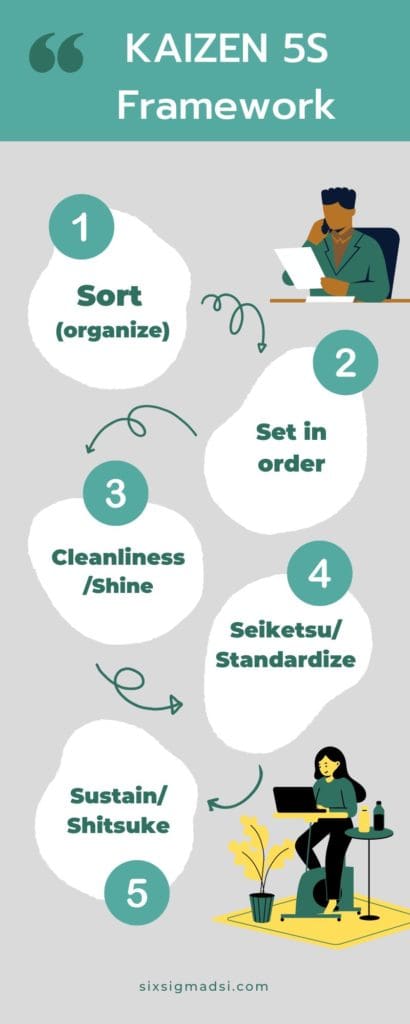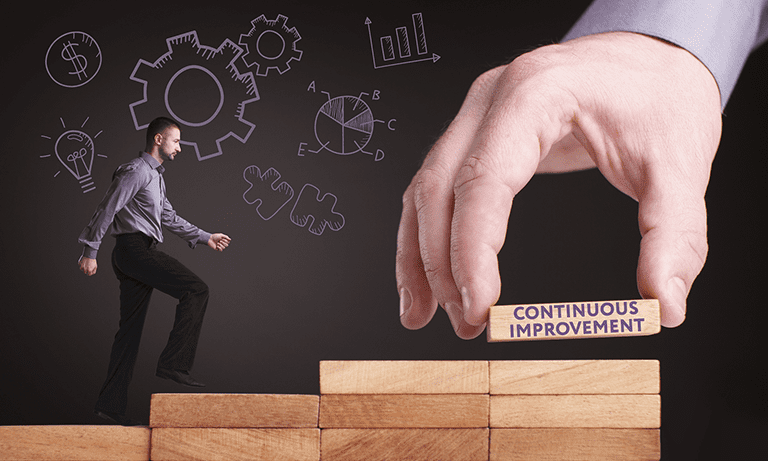Table of Contents:
What is Continuous Improvement Kaizen?
Continuous Improvement (Kaizen) is the philosophy of a strategy that encourages employees from all levels to work together to make incremental improvements to manufacturing processes. It is a way to combine the talents of all employees within a company and create an engine for improvement.
Kaizen is a method of continuous improvement that focuses on small, positive changes that can lead to significant improvements. It is typically based on cooperation, and commitment, and contrasts with top-down transformational approaches. Continuous improvement is the core of lean manufacturing and The Toyota Way. It was created in the manufacturing industry to reduce defects, eliminate waste and increase productivity.
It is a broad concept with many interpretations and has been used in many industries, including healthcare. It can be used in any industry and at any level. There are many tools and approaches to Kaizen. Value stream mapping documents analyze and improve information and material flows to create products or services. Total Quality Management is a framework for managing workers to improve quality. No matter what method you use, continuous improvement is only successful when there is support from all levels of the organization.
Kaizen is a combination of two Japanese words which translate to “good change” and “improvement.” Kaizen, however, has been interpreted as “continuous improvement” because of its association with lean principles and methodology.
Kaizen was born in post-World War II Japanese quality circles. These groups or circles of workers were focused on preventing Toyota defects. These circles were created partly as a response to American productivity consultants and management who visited Japan, particularly W. Edwards Deming who believed that quality control should be more directly in the hands of line workers. Masaaki Imai’s book Kaizen, The Key to Japan’s Competitive Successin 1986 brought Kaizen to the West.

Kaizen: 10 Principles
Kaizen is about fostering a culture of excellence in a company. These 10 principles are often referred to as the core of the philosophy. These are:
- Don’t hold on to your assumptions.
- Take the initiative to solve problems.
- Do not accept the status quo.
- Don’t be a perfectionist and adopt an attitude that is iterative and adaptive.
- As you make mistakes, look for solutions.
- Make sure everyone feels empowered to make a contribution.
- Do not accept the obvious problem; instead, ask five times “Why” to find the root cause.
- Collect information and opinions from many people.
- You can use your creativity to make small, low-cost improvements.
- Never stop learning.
The Dual Nature of Kaizen System
Kaizen can be described as a combination of philosophy and action plan.
- Kaizen, which is an action plan, is about organizing events that focus on improving certain areas of the company. These events are open to all employees, and a strong emphasis is placed on the involvement of workers from the plant floor.
- Kaizen, as a philosophy, is about creating a culture in which all employees are involved in suggesting and implementing changes to the company. It becomes a natural way for managers and employees on the plant floor to think in lean organizations.
Kaizen is a complement to Standardized work. Continuous improvement seeks to improve the standardized work process. Standardized Work is a collection of best practices. You will notice the emphasis on “current”; Standardized Work is constantly evolving through Kaizen.
Kaizen Events
The continuous improvement process is something like this.
- Set goals and give background information if necessary.
- Examine the situation and create a plan to improve it.
- Implement improvements.
- Reexamine and correct what isn’t working.
- Report the results and identify any follow-up items.
This continuous improvement process cycle is often referred to as PDCA. (Plan, Do. Check. and Act). PDCA is a scientific approach to improving things:
- Develop a hypothesis
- Do: Run the experiment
- Evaluate the results
- Refine your experiment, then begin a new cycle
Kaizen 5S framework

The Kaizen system is incomplete without a 5S framework. It creates a perfect physical workplace. The 5Ses are focused on visual order, organization, and cleanliness to increase profitability, efficiency, and safety. Below is a list of the 5Ses in Japanese and their English translations.
- Sort (organize). Separate the essential workplace items from the unnecessary and get rid of them.
- Set in order/Create orderliness. Arrange items so that they are easy to find in a way that makes sense for your work.
- Cleanliness/Shine
- Seiketsu/Standardize (standardized cleaning). Systematize workplace cleanup best practices.
- Sustain/Shitsuke (discipline). Keep going.
Continuous improvement through Kaizen Cycle
Kaizen can be applied in seven steps to creating an environment that encourages continuous improvement. These steps are part of this systematic approach:
- Engage employees. Ask employees for their involvement, and ask them to help you identify problems. This will encourage employees to support change. This is often done by establishing specific groups of people who are responsible for gathering and relaying information from a larger group of employees.
- Collect feedback from employees to identify problems and possible solutions. If there are multiple issues, create a list.
- Find a solution. Inspire employees to come up with creative solutions. Choose one or more winning solutions from the suggestions.
- Use the solution to test it. Have everyone involved in the rollout. To test the solution, create pilot programs.
- Review the results. Make plans to monitor progress at various times. Develop specific plans that will identify who will be the point of contact and how to keep workers on the ground engaged. Find out how successful the change was.
- Positive results can be adopted throughout an organization.
- These seven steps need to be repeated regularly, with new solutions being tested as necessary or new problems being tackled.
The Kaizen Philosophy
Kaizen is an action plan that develops the continuous improvement philosophy. Kaizen can be applied as an action plan by employees through a continuous and sustained program that includes Kaizen events. This will teach them to think differently about work. Kaizen is a continuation application that creates a culture of continuous improvement and provides tremendous long-term value.
Kaizen examples
Toyota is the most well-known company for using continuous improvement. However, other companies have also successfully applied the method. These are just three examples.
- Lockheed Martin. This aerospace company is a strong proponent of continuous improvement. The company has successfully used Kaizen to reduce manufacturing costs, inventory, and delivery times.
- Ford Motor Company. In 2006, Ford was in danger of going bankrupt. Mulally used Kaizen for one of the greatest corporate turnarounds in human history.
- Pixar Animation Studios. Pixar used a continuous improvement to decrease the risk of costly movie failures by using quality control checks, iterative processes, and iterative procedures.

Kaizen’s advantages and disadvantages
It can be a great tool for organizations for many reasons. However, it’s not always the best fit for every situation. These are some of Kaizen’s benefits and drawbacks:
Kaizen advantages
- Kaizen’s emphasis on gradual improvement can lead to a more gentle approach to change than big efforts that might be abandoned because of their tendency to cause resistance and pushback.
- Continuous improvement encourages the examination of processes to reduce waste and mistakes.
- There are fewer mistakes, which means that oversight and inspection requirements can be reduced.
- It promotes a sense of value and purpose, which improves employee morale.
- Employees think beyond their departments to increase teamwork.
- Employees become more attentive to customer needs, which increases client focus.
- To encourage improvements in both the short- and long-term, systems are in place.
Kaizen disadvantages
- Closed communication cultures and companies with a culture of territorialism may need to first focus on cultural changes in order to create an environment that is more open to new ideas.
- Continuous improvement events that are short-term may cause a temporary burst in excitement, but it is usually not sustainable.












